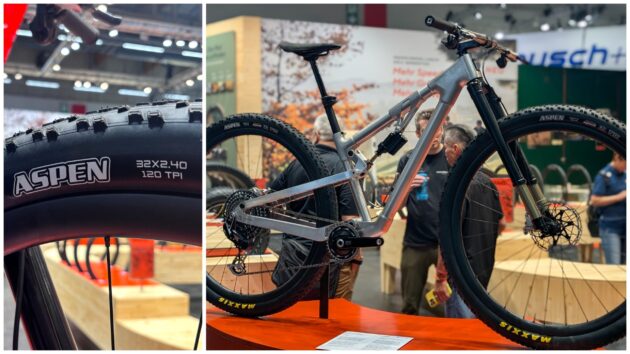Ugly, heavy, ungainly – I hope mountain biking's latest flirtation with bigger wheels stays on the sidelines.
I’ve been around long enough to bear the emotional scars of the last wheel size war in mountain biking, but while we’ve enjoyed peace and harmony on the trails recently, I fear a new wheel size clash is brewing. 32in wheels are about to roll over the same ground we covered with 29in and 27.5in, dividing opinion, stirring emotion and eating up resources, and what for? I’m not sure.
At a time when bike brands need to be refining and consolidating their ranges, along comes a new ‘standard’ to expand consumer choice and proliferate SKUs. Not to mention the new tyres, rims, and forks that will be needed to run these oversized wagon wheels. If that sounds like a massive waste of time, effort, and money, then I’m with you. And let me explain why.

The first 29er I rode was the Santa Cruz Tallboy in 2009. Can you see why I rejected bigger wheels out of hand?
Getting over my hatred for 29in wheels taught me a valuable lesson
Before that, a confession. I’ll freely admit I was wrong about this before, and I’ll probably be wrong again. Back in the early 2010’s, I took a strong dislike to the emerging trend for 29er trail bikes. And my prejudices were mostly that, built on the shaky foundations of hating how they looked. The only actual ride time I’d had on one was a quick lap of a car park. I did all the things a good bike tester shouldn’t do; base my initial opinion purely on aesthetics and a fleeting spin on a sample of one.
And yet, at the same time, I was right. The geometry on those early bikes was all wrong. The head angles were too steep, the front centres were too short, and the tyres were terrible. As the bike industry got its head around the bigger wheels, and the bikes improved. I started to warm to them, and eventually, by about 2013, I wouldn’t ride anything else. Not an early adopter then, but certainly not jumping on the bandwagon.

The first 29er I really gelled with was the Norco Shinobi 1. From that point I didn’t look back.
Beyond changing my attitude, I learnt a vital lesson – always remain open minded. So why am I adopting old (bad) habits again, and dismissing 32in wheels before I’ve even ridden them? Well, you know how geometry kept growing and growing until it reached a point where bikes were too big and too slack, and everyone started to pull back a bit? Or how travel went longer and longer until there were 12in beasts that needed a stepladder to climb aboard? Well I think that’s going to happen with wheel sizes. Probably e-bike motor power too, but that’s a debate for another day. At some point the pros start to be outweighed by the cons, and designers and engineers begin to row back.

The Faction Bike Company 32in wheel prototype on the Maxxis stand at Eurobike has several obvious compromises.
What’s are the pros and cons of 32in wheels?
With 32in wheels, the main potential benefits are greater stability and improved rollover, while the drawbacks include weight, inertia, strength, and packaging. And it’s the significance of these drawbacks that, I believe, will ultimately put a stick in the spokes of 32in momentum. Even in the discipline most likely to adopt the larger diameter – namely XC racing.
For starters, a 32in wheel will be heavier than 29in wheels. Let’s say 10% heavier for the sake of simplicity – on a typical XC wheelset that’s going to add around 300g of mostly rotating mass. But the larger wheel will also be weaker, so it’s likely they’re going to have to use proportionally more material to reinforce the tyre and rim, so I’d expect that figure to be even higher. XC racers hate extra weight, so 32in wheels will really need to bring significant speed or efficiency benefits to overcome that. Given that modern World Cup courses are way more technical, with lots of awkward corners and changes of direction, my hunch is that any extra rolling speed may be overshadowed by the reduced manoeuvrability and additional inertia.

Can you imagine tackling a feature like this from the 2023 World Championships with an 3in larger wheel? Bartek Wolinski / Red Bull Content Pool
Geometry and suspension packaging will be a big headache
Testing on a variety of tracks will give bike brands and race teams a better understanding of whether bigger wheels are faster overall, but I think the biggest barrier to the 32in wheel is geometry. Accommodating bigger wheels and making the bike handle well is going to be a real challenge. Probably too big. Chainstays are going to get longer. Suspension travel is going to have to get shorter. Seat tubes may end up getting slacker to give enough tyre clearance at full travel. Frames will get heavier. Forks will get longer. Stack heights will get taller. And engineers will be doing all sorts of weird things to get bar heights down into that flat-back position that XC racers love. Which is why that BMC prototype doing the rounds in Andorra looks so kooky.

So far Maxxis is the only major tyre brand to publicly get behind 32in wheels.
Likewise the prototype on the Maxxis stand at Eurobike, built to showcase the brand’s 32in Aspen XC tyres, has some obvious compromises. Produced by Faction Bike Studio – an engineering consultancy company to the bike industry – it has a super slack actual seat angle that will put stress on the dropper, make it difficult to keep the front end down on steep climbs, and exacerbate any pedal bob when in the saddle.

32in too small for you? You could always size up to the DirtySixer.
Yes it’s early days, and these are the only two prototypes I’ve seen – I’m sure the likes of Trek and Specialized also have their own test rigs – but given how we’ve been through all this before when moving from 26in to 29in, I’d expect these mules to look less like donkeys.

An Intend BC inverted fork gets around the clearance issues of a bigger front wheel, and the lack of fork availability, but introduces a number of other problems.
Gains too marginal to be worth the cost?
Ok, that’s harsh, and there may well be a very, repeat VERY, small niche of riders for whom 32in wheels will work. I’d expect them to be on the taller side of the spectrum, obviously. But will that be enough to make it worth tyre brands, wheel brands, fork brands, and bike brands investing in bigger wheels as a commercial prospect? I doubt it. There’s just not enough cash sloshing around at the moment to risk it. And if bigger wheels look marginal in XC racing, there’s no way they’re going to make it to trail and enduro riding, where travel is longer and bikes need to be tougher. Imagine the weight of a 32×2.5in tyre with a reinforced enduro casing? It’ll be approaching 2kg. For that reason along it’s never going to catch on, let alone the geometry issues.

Could 32in wheels find its true calling on gravel bikes?
32in wheels’ future is cast in gravel
One place I do see 32in wheels taking over is gravel. No question. When there’s nothing technical about the terrain, and you’re basically sat in the same position for six hours or trying to maintain 25mph, then I reckon 32in wheels will be a huge benefit. Plus there are fewer challenges with regard to frame geometry and no need for things like suspension forks.
So that’s my best guess. I’ll probably be totally wrong. Let me know how wrong you think I’m going to be by emailing mbr@futurenet.com.




